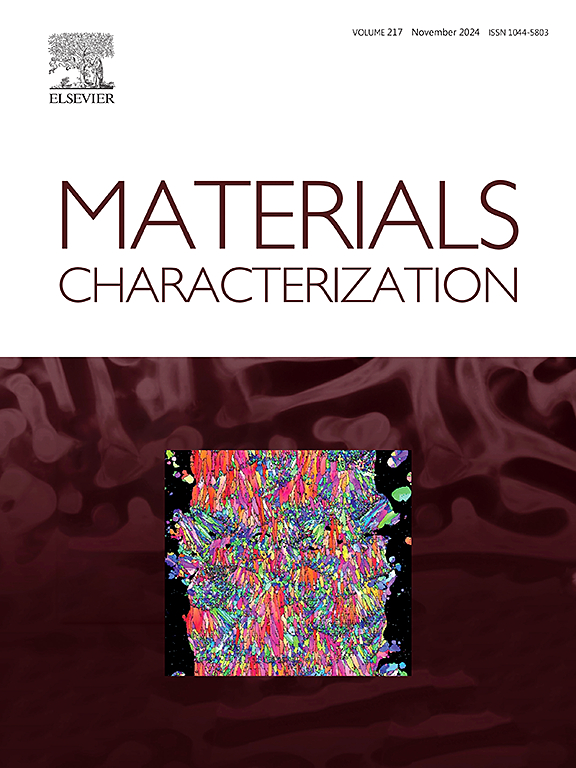高强度cu基纳米复合材料的缺口容限
IF 4.8
2区 材料科学
Q1 MATERIALS SCIENCE, CHARACTERIZATION & TESTING
引用次数: 0
摘要
了解复合材料的缺陷容忍度对于可靠结构材料的设计和应用至关重要。通过单轴拉伸实验,我们通过实时应变映射探索了cu -氧化铝和Cu-Ag-Zr复合材料的缺口相关塑性变形机制。实验表明,在两种材料的缺口对拉伸载荷下,高应变区首先从缺口尖端出现,然后发展成应变集中带。在进一步的载荷下,这些条带的形状从直线变为椭圆,因为它形成了一个桥,横跨到相反的缺口尖端。任一试样受拉伸时,其缺口尖端半径增大,应变集中带逐渐向缺口段中心移动。高塑性应变不仅局限于缺口尖端,而且也局限于应变集中带。缺口强化主要出现在应变-浓度带内。两种复合材料在这些带内表现出不同的延展性。铝颗粒增强的Cu具有较低的伸长率,最终导致这些带内某处突然断裂。相比之下,ag纤维增强Cu-Ag-Zr纳米复合材料在应变浓度带具有较高的伸长率,并伴有明显的缺口钝化。换句话说,ag纤维增强Cu比铝颗粒增强Cu具有更高的缺陷容忍度,我们将这种差异归因于可锻纤维和硬颗粒之间的差异。本文章由计算机程序翻译,如有差异,请以英文原文为准。
Notch tolerance of high-strength Cu-based nanocomposites
Understanding flaw tolerance in composites is critical for both the design and the application of reliable structural materials. Through uniaxial tension experiments, we explored notch-related plastic deformation mechanisms in both Cu-alumina and Cu-Ag-Zr composites via real-time strain mapping. Experiments demonstrated that, in samples under tensile loading with notch pairs from both materials, highly strained regions first emerged from notch tips and then developed into strain-concentration bands. Under further loading, each of these bands changed in shape from straight to elliptical as it formed a bridge across to its opposite notch tip. When any sample came under tension, its notch tip radius increased, and its strain-concentration bands gradually moved toward its notch segment center. High plastic strain became localized at the notch tips, of course, but also within the strain-concentration bands. Notch-strengthening, on the other hand, appeared mainly within the strain-concentration bands. The two composites showed different ductility within these bands. Alumina-particle-strengthened Cu had low elongation that eventually resulted in an abrupt fracture somewhere within these bands. By contrast, Ag-fiber-strengthened Cu-Ag-Zr nanocomposites had high elongation in strain-concentration bands, accompanied by clear notch blunting. In other words, Ag-fiber-strengthened Cu had higher flaw tolerance than alumina-particle-strengthened Cu, a difference we attributed to the differences between malleable fibers and hard particles.
求助全文
通过发布文献求助,成功后即可免费获取论文全文。
去求助
来源期刊

Materials Characterization
工程技术-材料科学:表征与测试
CiteScore
7.60
自引率
8.50%
发文量
746
审稿时长
36 days
期刊介绍:
Materials Characterization features original articles and state-of-the-art reviews on theoretical and practical aspects of the structure and behaviour of materials.
The Journal focuses on all characterization techniques, including all forms of microscopy (light, electron, acoustic, etc.,) and analysis (especially microanalysis and surface analytical techniques). Developments in both this wide range of techniques and their application to the quantification of the microstructure of materials are essential facets of the Journal.
The Journal provides the Materials Scientist/Engineer with up-to-date information on many types of materials with an underlying theme of explaining the behavior of materials using novel approaches. Materials covered by the journal include:
Metals & Alloys
Ceramics
Nanomaterials
Biomedical materials
Optical materials
Composites
Natural Materials.
 求助内容:
求助内容: 应助结果提醒方式:
应助结果提醒方式:


